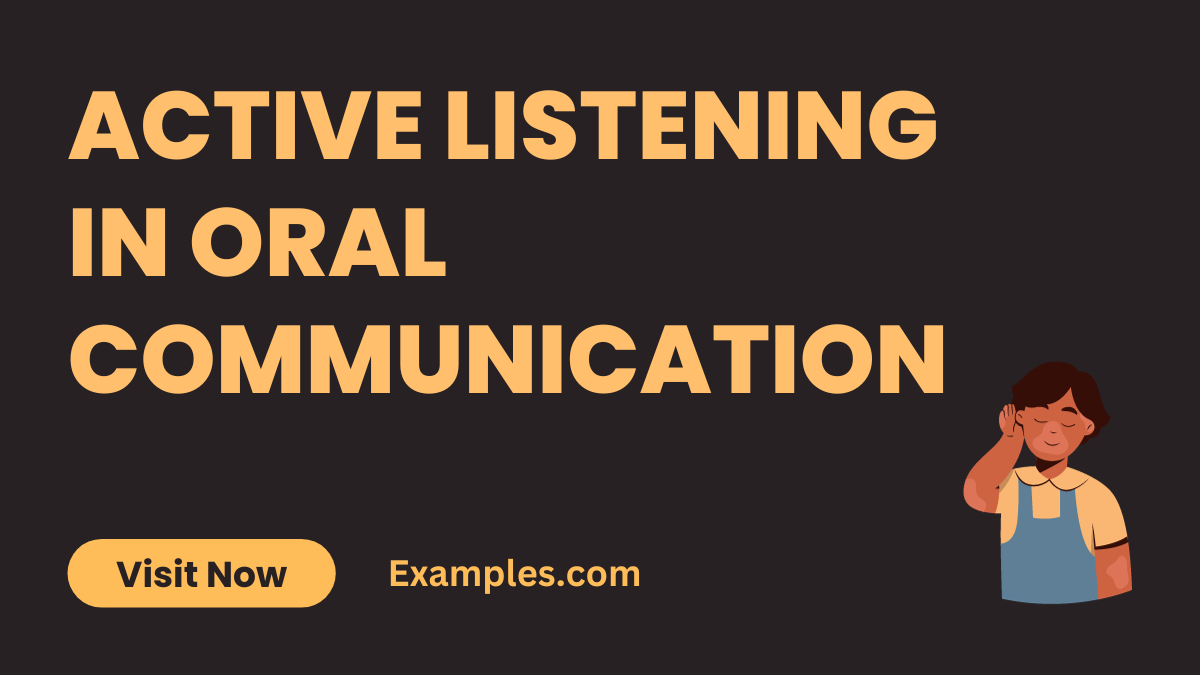29+ Active listening in Oral Communication Examples
Active listening in oral communication is a pivotal skill that goes beyond merely hearing words. It involves fully engaging with the speaker, understanding their message, and responding thoughtfully. This comprehensive guide illuminates the nuances of active listening, packed with practical communication examples and actionable tips. By mastering active listening, individuals can significantly enhance their interpersonal interactions, ensuring clarity and building stronger relationships. Whether in professional settings or personal conversations, the ability to actively listen is a key element for effective communication.
What is Active Listening in Oral Communication?
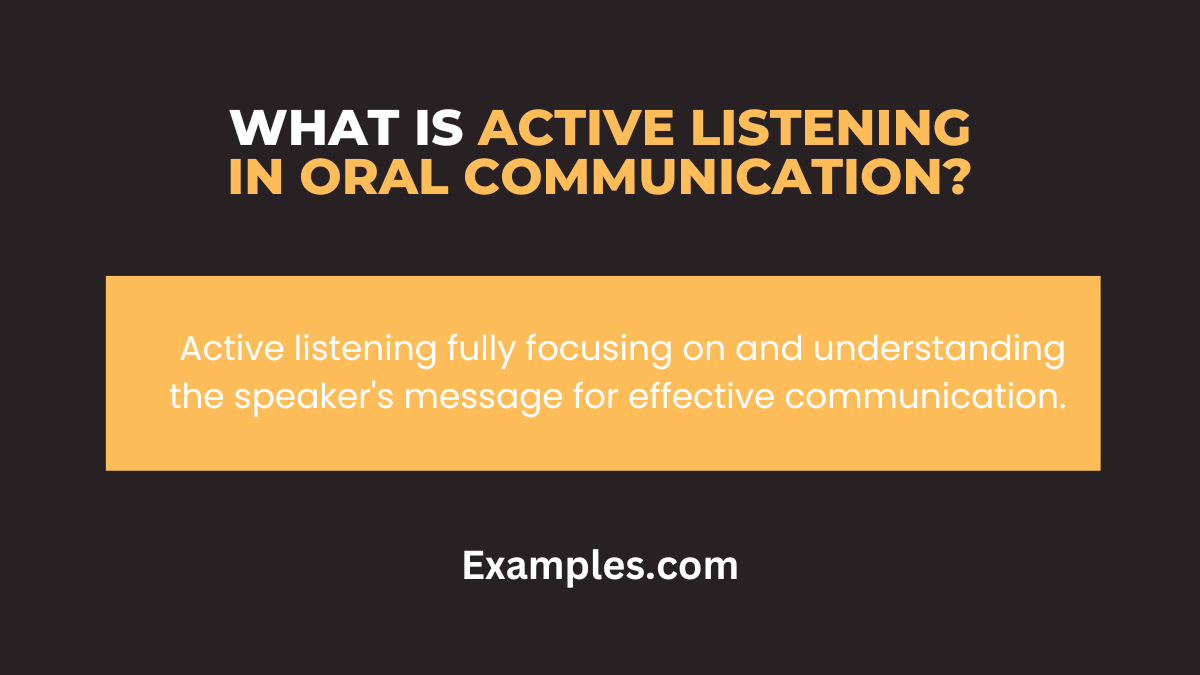
Active listening in oral communication is a method of listening that involves fully concentrating, understanding, responding, and then remembering what is being said. It’s more than just hearing the words; it’s about paying close attention to the speaker’s message and intentions. Active listening involves engaging with the speaker through eye contact, nodding, and providing feedback. It is a crucial skill for effective communication as it ensures that the listener fully comprehends the speaker’s point of view and can respond thoughtfully. This approach fosters a deeper understanding and connection between the speaker and the listener.
What is the Best Example of Active Listening in Oral Communication?
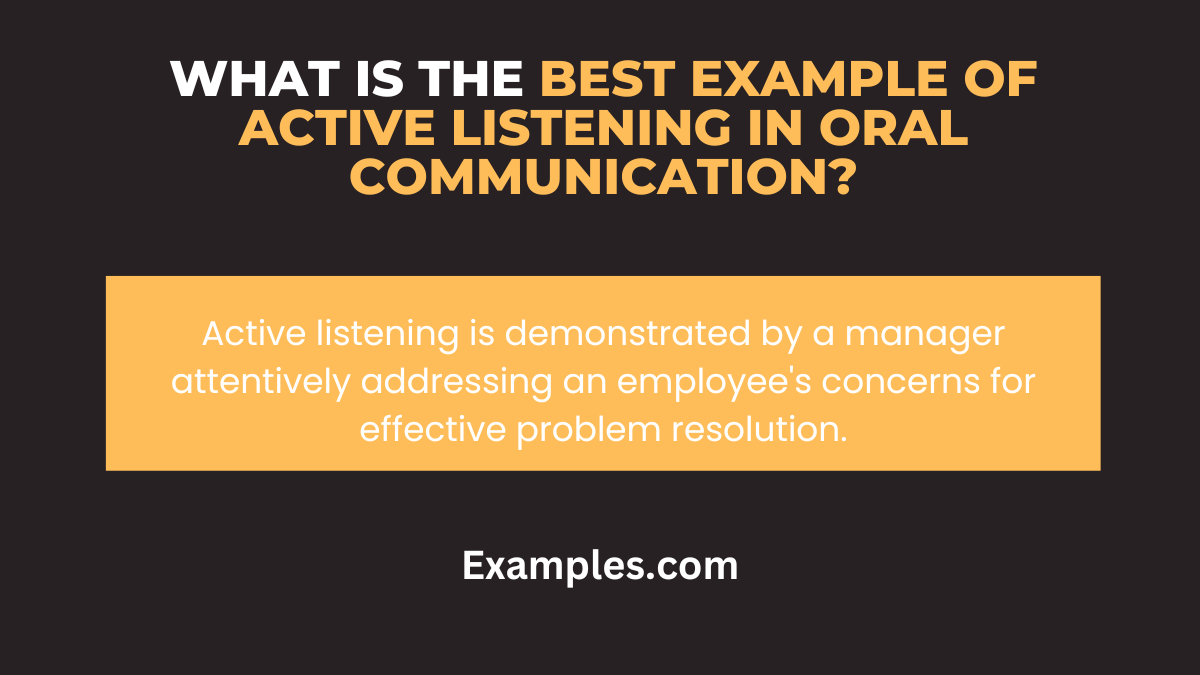
A prime example of active listening in oral communication occurs during a problem-solving session. Imagine a manager listening to an employee’s concerns about workplace challenges. The manager practices active listening by maintaining eye contact, showing empathy, asking clarifying questions, and paraphrasing the employee’s words to ensure understanding. This approach not only helps in accurately identifying the problem but also makes the employee feel heard and valued. The manager’s active listening paves the way for a constructive dialogue, leading to effective solutions and a stronger working relationship. This scenario demonstrates how active listening is essential in achieving clear, respectful, and productive oral communication.
30 Examples of Active listening in Oral Communication
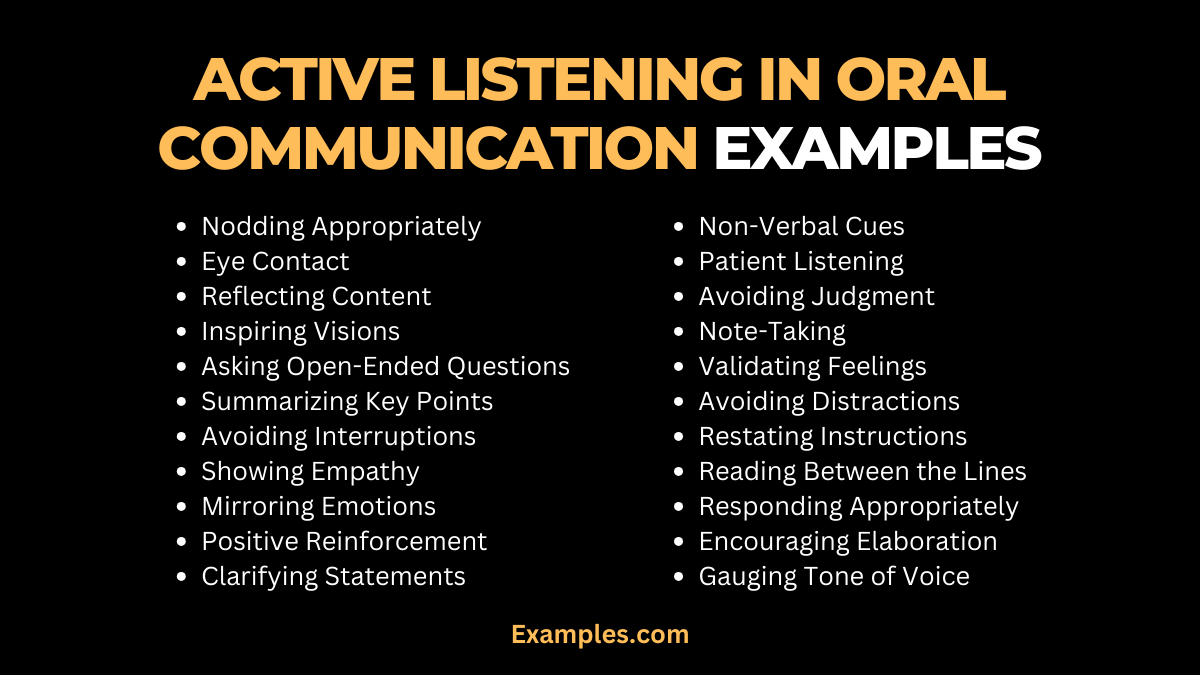
Active listening in oral communication is pivotal for effective interactions. It entails fully engaging with the speaker, understanding their message, and responding thoughtfully. Incorporating techniques like making eye contact and providing feedback, it’s crucial in both personal and professional settings. Active listening enhances understanding, builds relationships, and fosters a collaborative environment.
- Nodding Appropriately: Indicates you are following along.
Example: As the speaker discusses a point, nod to show understanding. - Eye Contact: Maintains connection without staring.
Example: Keep eye contact for a few seconds at a time to show attentiveness. - Reflecting Content: Paraphrasing the speaker’s message.
Example: “So, you’re saying that…” - Asking Open-Ended Questions: Encourages elaboration.
Example: “Can you tell me more about this aspect?” - Summarizing Key Points: Demonstrates understanding.
Example: “To summarize, your main concern is…” - Avoiding Interruptions: Lets the speaker finish their thoughts.
Example: Wait for a natural pause before speaking.
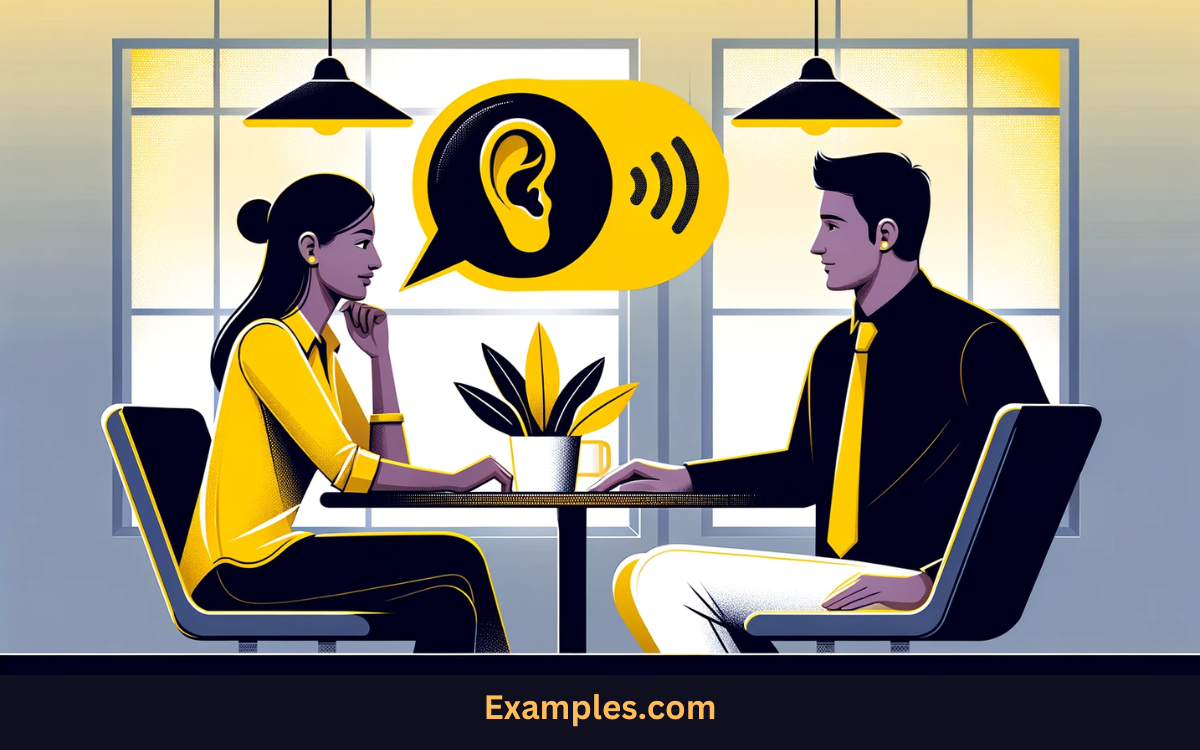
- Showing Empathy: Understands the speaker’s emotions.
Example: “It sounds like that was a challenging situation for you.” - Mirroring Emotions: Reflects the speaker’s feelings.
Example: Show concern if the speaker is upset. - Positive Reinforcement: Encourages the speaker.
Example: “I appreciate your sharing this with me.” - Clarifying Statements: Seeks to understand better.
Example: “Could you clarify what you mean by…” - Non-Verbal Cues: Using gestures to show engagement.
Example: Lean forward slightly to show interest. - Patient Listening: Not rushing the speaker.
Example: Take time to let the speaker express fully.
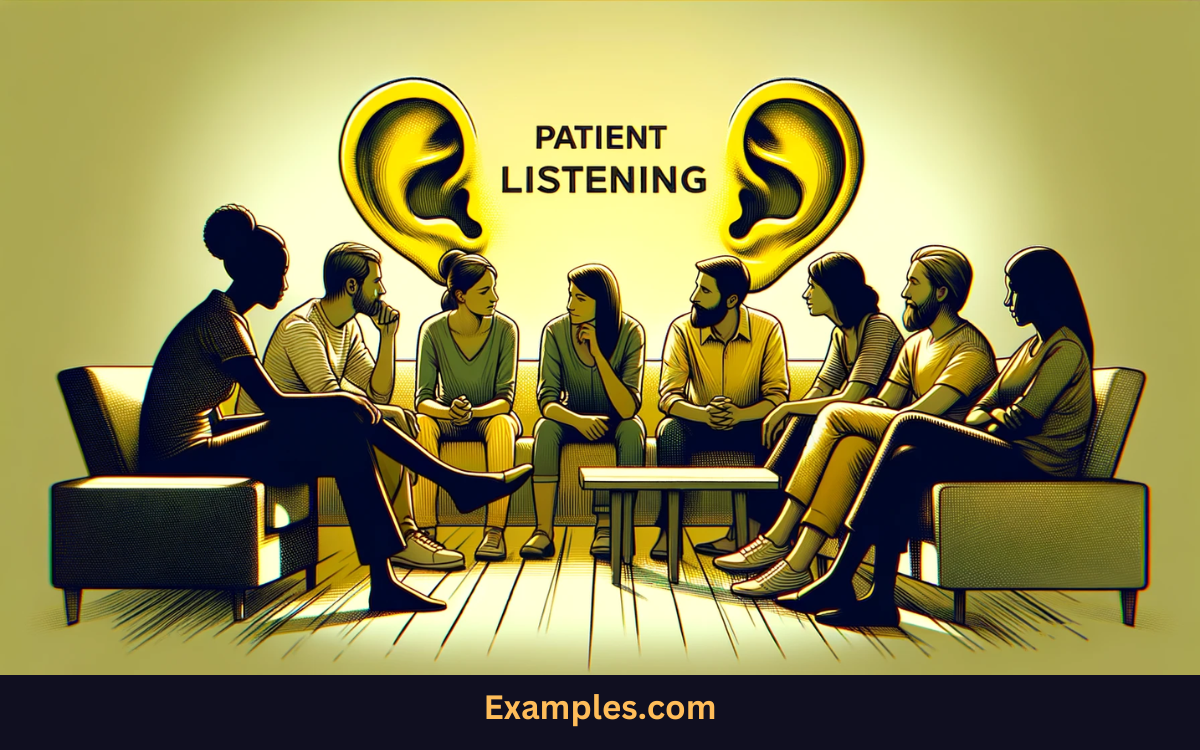
- Avoiding Judgment: Keeping an open mind.
Example: Refrain from immediately evaluating the speaker’s points. - Note-Taking: For important details.
Example: Jot down key points to recall later. - Validating Feelings: Acknowledging emotions.
Example: “It’s understandable to feel that way.” - Avoiding Distractions: Focusing solely on the speaker.
Example: Put away mobile devices during the conversation. - Restating Instructions: For clarity in tasks.
Example: “So, I will need to complete this by Friday, correct?” - Reading Between the Lines: Understanding implied meanings.
Example: Detect subtleties in the speaker’s tone or choice of words. - Responding Appropriately: Tailoring your response.
Example: “Based on what you’ve said, I think…”

- Encouraging Elaboration: Prompting further explanation.
Example: “Could you expand on that point a bit?” - Gauging Tone of Voice: Listening to vocal nuances.
Example: Identify shifts in the speaker’s tone for emotional cues. - Respecting Silence: Allowing thoughtful pauses.
Example: Don’t rush to fill every silence in the conversation. - Providing Feedback: Sharing your thoughts constructively.
Example: “I agree with your point on…” - Adapting to Communication Style: Matching the speaker’s style.
Example: If the speaker is formal, respond similarly. - Showing Interest: Expressing genuine curiosity.
Example: “That’s interesting, can you tell me more?” - Recognizing Non-Verbal Signals: Observing body language.
Example: Notice if the speaker’s posture indicates comfort or tension. - Recalling Previous Points: Referencing earlier parts of the conversation.
Example: “Earlier, you mentioned that…” - Being Non-Confrontational: Keeping the conversation friendly.
Example: Avoid aggressive language or tone. - Offering Encouragement: Motivating the speaker.
Example: “You’re making great points, go on.” - Asking for Clarification: Ensuring full understanding.
Example: “I want to make sure I understand, did you mean…”
What are the Benefits of Active listening in Oral Communication?
- Enhances Understanding: Active listening ensures a deeper comprehension of the speaker’s message.
- Builds Stronger Relationships: It fosters trust and respect between the speaker and listener.
- Improves Problem-Solving: Active listening helps in accurately identifying and addressing issues.
- Increases Engagement: Listeners are more engaged and invested in the conversation.
- Reduces Misunderstandings: It minimizes the chances of misinterpreting the speaker’s words.
- Encourages Open Communication: Creates an environment where speakers feel heard and understood.
- Boosts Productivity: Effective listening leads to more productive discussions.
- Enhances Decision Making: By fully understanding all viewpoints, better decisions can be made.
What are the Techniques of Active listening in Oral Communication?
- Maintain Eye Contact: Shows attentiveness and respect.
- Nonverbal Encouragement: Nodding and smiling to show understanding.
- Reflective Listening: Paraphrasing to show comprehension.
- Asking Open-Ended Questions: Encourages detailed responses.
- Avoiding Interruptions: Letting the speaker finish without interruption.
- Providing Feedback: Offering thoughtful responses or clarification questions.
- Summarizing the Main Points: Ensures you have correctly understood the message.
- Demonstrating Empathy: Showing understanding of the speaker’s feelings.
Why is Active listening important in Oral Communication?
- Fosters Empathy: Helps understand the speaker’s perspective and emotions.
- Improves Collaboration: Essential for teamwork and collaborative efforts.
- Enhances Learning: Aids in absorbing and processing new information.
- Builds Rapport: Strengthens personal and professional relationships.
- Prevents Conflict: Reduces the chances of misunderstandings leading to disputes.
- Improves Customer Satisfaction: Essential in customer service and client interactions.
- Increases Efficiency: Prevents the need for repeated conversations.
- Promotes Inclusivity: Everyone feels valued and heard.
How to improve Active listening in Oral Communication?
- Practice Mindfulness: Stay present and focused during conversations.
- Control Your Responses: Avoid forming responses while listening.
- Develop Patience: Take time to listen without rushing the speaker.
- Enhance Your Memory: Work on remembering key points from conversations.
- Seek Clarification: Ask questions if you’re unsure about something.
- Eliminate Distractions: Focus fully on the speaker without external distractions.
- Regular Practice: Continuously practice active listening in various settings.
- Empathy Training: Develop skills to understand and share the feelings of others.
Active listening, beyond being a key element in effective oral communication, plays a significant role in building trust and understanding in various interactions. Whether in professional settings like business meetings or personal scenarios such as conversations with friends, active listening helps to create a deeper level of engagement and understanding. It’s a skill that not only benefits the listener by providing a clearer grasp of the discussion but also makes the speaker feel respected and valued. For an in-depth exploration of the importance of active listening and its impact on relationships, Atlassian’s blog offers valuable insights and practical examples.
Furthermore, active listening is crucial in specialized fields such as healthcare, where building trust with patients is fundamental. It involves more than just medical expertise; it requires empathetic communication and a genuine effort to understand patients’ concerns and needs. This approach not only improves patient outcomes but also strengthens the overall healthcare delivery system. To understand more about the role of active listening in trust-building within patient-nurse relationships, an informative article on PubMed provides detailed analysis and examples.



